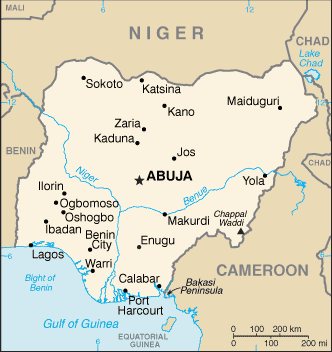Introduction: Niger and Its Mortality Rates
Niger has been known among the residents of Europe and America for its unique culture and original traditions for quite a while; however, since the 21st century, Niger’s reputation has changed drastically. Over the past decade, the very word “Niger” has become a staple for high infant mortality rates. Therefore, low awareness rates affect child mortality rates quite significantly. For the local healthcare specialists, spreading awareness regarding the significance of vaccination, as well as the disease prevention and key symptoms of specific diseases, including malaria and measles, which can be carried out with the help of modern technology, will help reduce the rates of child mortality within the state (Simpson, 2004).
Location/Geography
Niger is located in West Africa (lat.: 16.00° N, long.: 8.00° E) (CIA, 2014, sect. 3, para. 1–2) and is a part of the African Union. The capital of Niger is Niamey; the total area of Niger is 1.267 million sq km (CIA, 2014, sect. 3, para. 4). Niger is bordered by Algeria, Mali, Chad, Nigeria, Libya, Benin and Burkina-Faso (CIA, 2014, sect. 3, para. 6). The country is located in the Sahara and sub-Saharan areas, which predetermines its climate (subtropical; dry, very hot) and species diversity (low; limited flora vegetation (baobab, kapok) and many rare or extinct species, e.g., antelopes, warthogs) (Gifford-Gonzales & Hanotte, 2011). The Lake Chad, the Irhazer Lullemeden and the Niger River are the key water resources (USAID, 2012, pp. 8–9). Among the state’s key resources, coal, salt, iron, gold, phosphates, petroleum, uranium, tin, gypsum and molybdenum must be mentioned (CIA, 2014, sect. 2, para. 12).

Population
At present, 17,466,172 people live in Niger. Among these people, 55,4% are Haoussan, 21% are Djerma Sonrai, 9.3% are Tuareg, 8.5% are Peuhl, 4.7% are Kanouri Manga, and 1.2% belong to minorities (CIA, 2014, sect. 3, para. 5). 80% of the population are Muslim, and 20% are Christian for the most part (CIA, 2014, sect. 3, para. 7). The table below describes the age and gender relation among Nigeriens:
Table 1. Age-Gender Relations in Niger (CIA, 2014, sect. 3, para. 9; para. 18).
The population growth rate makes 3.28% (CIA, 2014, sect. 3, para. 9); the birth rate is 46.12 births/1,000 population (CIA, 2014, sect. 3, para. 10), while the death rate is 12.73 deaths/1,000 population (CIA, 2014, sect. 3, para. 11).
Government
The government type of Niger is republic (CIA, 2014, sect. 4, para. 2). Mahamadou Issoufou is the current president of the state. Niger is a republic with a constitution based on several previous ones (CIA, 2014, sect. 4, para. 2; para. 7).

Economy
Since the state is landlocked, most of its economy is based on the cooperation and trade with the states that surround it. Niger has managed to befriend both Muslim countries and the countries of Europe; as a result, Niger has managed to become a member of the UNO (United Nations Organization).
State of Health
Unfortunately, the current state of health in Niger leaves much to be desired. As it has been stressed, the mortality rates in Niger are deplorably high, and the fact that people are exposed to a number of diseases from the day that they are born only makes their chances for surviving even lesser. It should be noted that all of these hospitals are located in Niamey; therefore, the people living in remote areas have little to no access to the medical services provided to them by the state. As a result, death artes are going through the roof in Niger. It is truly tragic, because, according to the data provided by the CIA (Central Intelligence Agency), Niger takes the first place in the list of the countries with the highest birth rates (CIA, 2014a).
Culture/Traditional Medicine
As a state with a very rich history and complex culture, Niger has developed its own healthcare philosophy with its own version of alternative medicine. Needless to say, most of the medicine that the Nigerien people use as the alternative to the traditional one is based on the use of herbs. It is remarkable that Nigerien nurses practicing alternative medicine have a license and that alternative medicine is considered quite legitimate in the state (WHO, 2012).
Healthcare System and Delivery
The Nigerien healthcare system seems to be very flawed at present. Even though the WHO (World Health organization) has provided Niger with the resources needed for the faster reconstruction of its healthcare system, the state still fails to provide its residents with the support that they need.
Governmental Health-Related Agencies and Health Regulatory Organizations
There are a couple of key government supported healthcare services in Niger. They are supposed to provide patients with the standard services, including vaccination, health checks, etc. The most significant ones include the National Hospital (Niamey), Lamordé University Hospital (Niamey), La Maternité Issaka Gazoby (Niamey), Gamkalley Clinic (Niamey) and CURE Hôpital des Enfants au Niger (Niamey) (ALTEN, 2006).
Healthcare Personnel
According to the recent data, in Niger, there are 11.3 nurses per a physician on average (WHO, 2012).
Nursing Education System and Accrediting Organizations
Unfortunately, Niger does not provide its nurses with an opportunity to learn more about the latest advances in healthcare. Despite the endeavors of the UNO and WHO, Nigerien nursing education remains at a relatively low level due to the economic issues within the state (Clopper & Uys, 2012).
Nursing Associations
At present, there are no nursing associations on Niger, which the drastic mortality rates among Nigerien children can be explained with. On the one hand, the creation of a new nursing association within the state will demand impressive financial reserves.
Health Priorities
As it has been stressed above, the key mystery with the Nigerien healthcare is that, though the state admittedly lands on the top position in the number of childbirths per year, it still has the highest mortality rates not only in Africa, but also in the entire world. A closer analysis of the data represented above will reveal that the number of population in Niger changes drastically at the point when people reach the age of 15. Indeed, according to the information provided by the 2014 Census, very few people actually live to reach the age of 15. Therefore, it can be suggested that poor living and working conditions, as well as the lack of proper healthcare services available, affect the rates of mortality within the state.
As the data provided above shows, among the aforementioned factors defining extremely high mortality rates within the state and the mortality rates among children in particular, the increasing amount of instances of malaria should be mentioned. In other words, it is crucial that the vaccination against malaria should be introduced into the Nigerien healthcare system as an obligatory requirement for all Nigerien children to undergo.
In addition, to address the tuberculosis issue, which brings the number of Nigerien residents considerably lower, it will be required to create the healthcare facilities, where people can retrieve free or, at the very least, very cheap services for tuberculosis prevention and treatment. Finally, regarding tuberculosis, a major awareness campaign must be carried out so that people could adopt the proper strategy of addressing the issue and know where to receive the appropriate help and support.
Nursing Implications
As the information provided above shows, the Nigerian healthcare system requires a thorough reconsideration. However, an average nurse can also contribute to the evolution of the quality of the Nigerian healthcare. It can be suggested that two key steps should be made by each healthcare specialist in Niger, including the nursing staff. First and most obvious, the Nigerien nurses should follow and promote lifelong learning; thus, it will be possible for nurses in Niger to remain competent and acquire new skills so that they could assist patients efficiently. This should be conducted with the help of the latest technology (Smith, 2004), including social networks and medical gadgets (Trunell, 2010, July 7). The next step concerns raising awareness among the residents of Niger. Indeed, the inability to recognize the basic symptoms of diseases, as well as the unwillingness to vaccinate children, seems to be the key to the steep rise in mortality rates among the Malaysian population. Once people are provided with the necessary information and the corresponding facilities, they will be able to take care of their health, and providing them with these services is the priority of a nurse. The last, but definitely not the least, a Nigerien nurse is capable of joining or even starting an organization, which will promote knowledge, information sharing and skills training among the local nursing personnel.
Reference List
ALTEN. (2006). Review of child labour, education and poverty in Africa. Niger, Africa: AFETEN. Web.
Châtelot, C. (2011). Man of compromise takes power after military return Niger to civilian control. The Guardian. Web.
CIA. (2014). Algeria: Niger. Web.
CIA. (2014a). Country comparison: Birth rate. Web.
Clopper, H. C. & Uys, L. R. (2012). The state of nursing and nursing education in Africa. A country-by-country review. New York, NY: Sigma Theta Tau International Honor Society of Nursing.
Gifford-Gonzales, D. & Hanotte, O. (2011). Domesticating animals in Africa: Implications of genetic and archaeological findings. Journal of World Prehistory, 24(1), 1–24.
Simpson, R. (2004). No-borders nursing. How technology heals global ills. Nursing Administration, 28(1), 55–59.
Smith, C. (2004). The new technology continues to invade healthcare. Nursing Administration, 28(2), 92–98.
The University of Columbia. (n. d.). Niger. Web.
Trunell, A. (2010). Five improvised medical gadgets that save money and lives. Take Part. Web.
USAID. (2012). Niger. Wasshington, DC: USAID.
WHO. (2012). Young people’s views guide WHO advice on HIV prevention and care for those most at risk. Web.